Related Research Articles
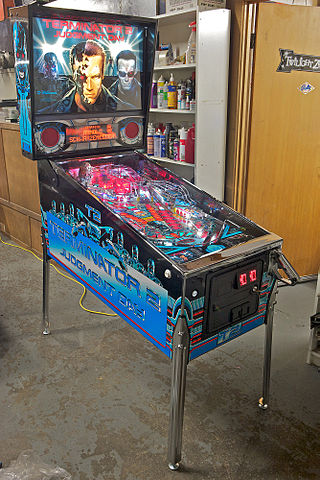
Pinball games are a family of games in which a ball is propelled into a specially designed table where it bounces off various obstacles, scoring points either en route or when it comes to rest. Historically the board was studded with nails called 'pins' and had hollows or pockets which scored points if the ball came to rest in them. Today, pinball is most commonly an arcade game in which the ball is fired into a specially designed cabinet known as a pinball machine, hitting various lights, bumpers, ramps, and other targets depending on its design. The game's object is generally to score as many points as possible by hitting these targets and making various shots with flippers before the ball is lost. Most pinball machines use one ball per turn, and the game ends when the ball(s) from the last turn are lost. The biggest pinball machine manufacturers historically include Bally Manufacturing, Gottlieb, Williams Electronics and Stern Pinball.
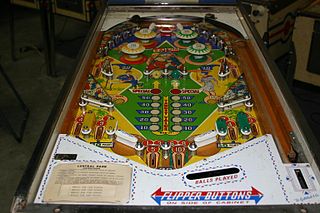
Gottlieb was an American arcade game corporation based in Chicago, Illinois. It is best known for developing the arcade game Q*bert.

Pinball Fantasies is a 1992 pinball video game originally developed by Digital Illusions and published by 21st Century Entertainment in Europe for the Amiga home computers. It is the sequel to Pinball Dreams, which was released earlier in the same year on multiple platforms. In the game, players can choose between any of the four available playfields, both of which have their own thematic and main objectives in order to obtain the highest score possible.
Stern is the name of two different but related arcade gaming companies. Stern Electronics, Inc. manufactured arcade video games and pinball machines from 1977 until 1985, and was best known for Berzerk. Stern Pinball, Inc., founded in 1999, is a manufacturer of pinball machines in North America.

Pokémon Pinball: Ruby & Sapphire is a 2003 pinball game developed by Jupiter, published by The Pokémon Company and distributed by Nintendo for the Game Boy Advance handheld game console. It was first revealed at E3 2003. The North American release was done to coincide with the fifth anniversary of the North American release of Pokémon Red and Blue. It is based on Pokémon Ruby and Sapphire, and is a sequel to Pokémon Pinball for the Game Boy Color. In some ways, it plays like a traditional pinball game, where the objective is to get a high score by keeping the ball in play as long as possible and hitting bumpers. In keeping with the theme of Pokémon, it features Pokémon collection, where while the players play pinball, they must also capture the eponymous creatures.
Baby Pac-Man is a hybrid maze and pinball game released in arcades by Bally Midway on October 11, 1982, nine months after the release of Ms. Pac-Man. The cabinet consists of a 13-inch video screen seated above a shortened, horizontal pinball table. The combination fits into roughly the same size space as an upright arcade machine. 7,000 units were produced.
A glossary of terms, commonly used in discussing pinball machines.
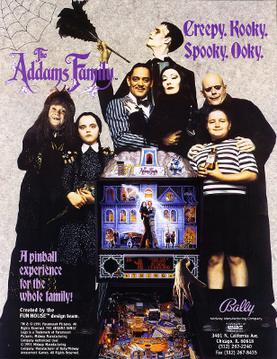
The Addams Family is a pinball machine released in March 1992. It was designed by Pat Lawlor and Larry DeMar and released by Midway. It was based on the 1991 film of the same name, and features custom speech by the stars of the film, Anjelica Huston and Raul Julia. It is the best-selling solid state pinball machine of all time with 20,270 units sold.

Pro Pinball: Timeshock! is an action video game developed by Cunning Developments and published by Empire Interactive for Microsoft Windows and PlayStation. It is the second game in the Pro Pinball series, and is themed around the concept of time travel.
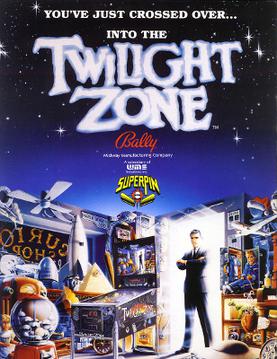
Twilight Zone is a widebody pinball machine, designed by Pat Lawlor and based on the TV series of the same name. It was first released in 1993 by Midway. This game is part of WMS' SuperPin line of widebody games alongside Star Trek: The Next Generation and Indiana Jones: The Pinball Adventure.
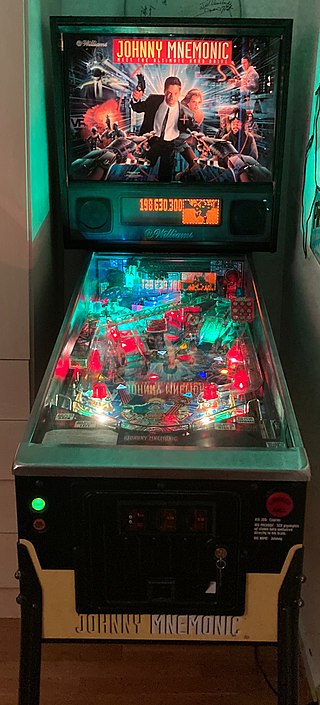
Johnny Mnemonic is a 4 player pinball machine from August 1995, manufactured by Williams Electronic Games, Inc. A total of 2,756 units were produced.
UltraPin is a Multi-Game pinball arcade game that holds 12 digital recreations of Williams Electronics real pinball games in a single pinball cabinet. UltraPin is built in a traditional style pinball cabinet to look and feel like a real pinball machine. It has two LCD screens, a 19 inch LCD for the back glass and DMD, and a 32 inch LCD for the playfield, and it uses Windows XP Embedded for its operating system.

The Flintstones is a pinball game released by Williams in 1994 and based on the movie of the same name which is based on 1960–1966 animated television series of the same name. This machine is not to be confused with another pinball machine, a redemption game, based on the TV series and also released in 1994, manufactured by Innovative Concepts in Entertainment (ICE).

Spider-Man is a pinball machine designed by Steve Ritchie and manufactured by Stern Pinball that was first released in June 2007. The table encompasses all three films in Sam Raimi's Spider-Man trilogy, which in turn were based on the prior comics and television series.
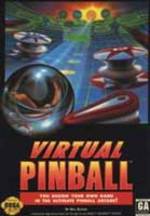
Virtual Pinball is a follow-up to EA's 1983 title Pinball Construction Set from the same author, Bill Budge, released 10 years later for the Sega Genesis. One to four players can choose from either 29 premade tables or design one using in-game editor tools. Designing options include ten different backgrounds and six themes, and a player can choose where objects are placed, the style of music, and the ball speed. Virtual Pinball lacks the unlimited floppy disc storage used by the original, and the ability to create self-booting disks that can be played without the construction set software.

The Who's Tommy Pinball Wizard is a pinball machine based on the rock musical The Who's Tommy. The machine features twenty-one songs from the musical sung by original Broadway cast members. The game was designed by Joe Kaminkow, Ed Cebula, Lonnie D. Ropp, and Lyman F. Sheats Jr. The machine was built using Solid-state electronics type components. The backbox of the machine has a dot matrix display with animations by Kurt Andersen and Markus Rothkranz. 4,700 machines were manufactured by Data East in January 1994.
Play Meter was an American trade magazine focusing on the coin-op amusement arcade industry, including jukebox and arcade game machines. It was founded in December 1974 by publisher and editor Ralph C. Lally II and it is published in physical form by Skybird Publishing on a monthly basis. Together with rival publication RePlay it chronicled the arcade industry from its nascency, through market fluctuations like the video game crashes of 1977 and 1983, and the rebirth and maturation of the medium through the 1980s. It is the earliest example of video game journalism, establishing such practices as individual video game reviews and the ten-point assessment scale for video game reviews.
Time Warp is a 4 player Solid State Electronic pinball machine from September 1979 produced by Williams. A total of 8,875 units were produced.
Bugs Bunny's Birthday Ball is a 1990 pinball game designed by John Trudeau and Python Anghelo and released by Midway. It is based on Warner Bros.' Looney Tunes and Merrie Melodies series of cartoons. This is the first of only two licensed pinball tables ever to feature the Looney Tunes characters.

An arcade game or coin-op game is a coin-operated entertainment machine typically installed in public businesses such as restaurants, bars and amusement arcades. Most arcade games are presented as primarily games of skill and include arcade video games, pinball machines, electro-mechanical games, redemption games or merchandisers.
References
- 1 2 "Interview: Roger Sharpe". Pinball Magazine. 15 August 2012. Retrieved 7 October 2021.
- ↑ Blitz, Matt (August 16, 2013). "How One Perfect Shot Saved Pinball From Being Illegal". Gizmodo . Retrieved 7 October 2021.
- ↑ Klien, Christopher. "That Time America Outlawed Pinball". History. Retrieved 8 October 2021.
- 1 2 3 McKay, Daniel. "The Man Who Saved Pinball". OnWisconsin. Retrieved 7 October 2021.
- ↑ Harding, Matt (July 30, 2021). "Pinball Movie Based on Roger Sharpe Coming Soon". RePlay Magazine. Retrieved 8 October 2021.
- 1 2 3 4 5 Smith, Ryan (May 3, 2018). "The First Family of pinball: Meet the local wizards behind the game's huge resurgence". Chicago Reader . Retrieved 7 October 2021.
- ↑ Kleinfield, N R (October 17, 1983). "Video Games Industry Comes Down to Earth". The New York Times . Retrieved 10 October 2021.
- ↑ "IFPA Staff". International Flipper Pinball Association. Retrieved 8 October 2021.